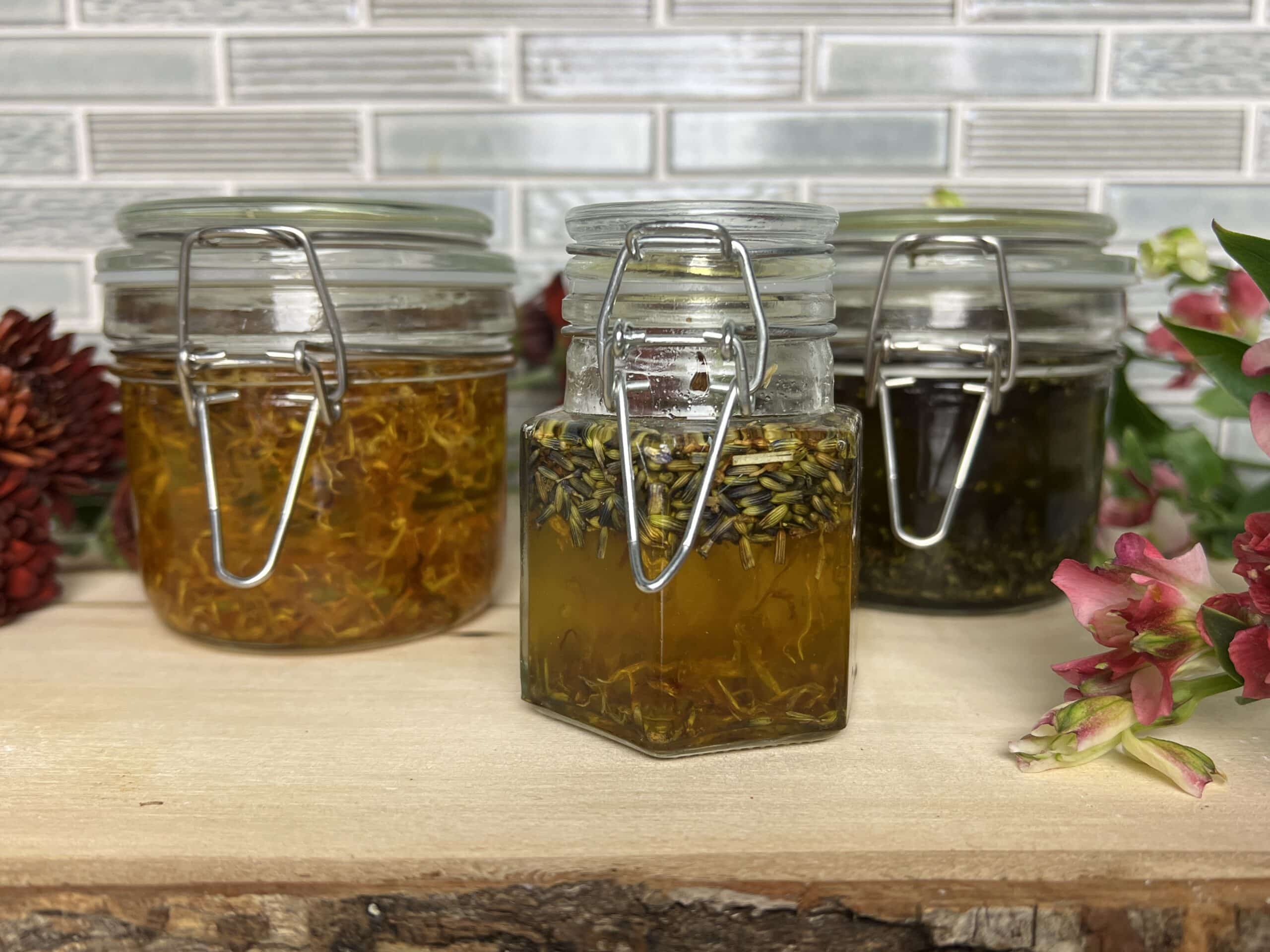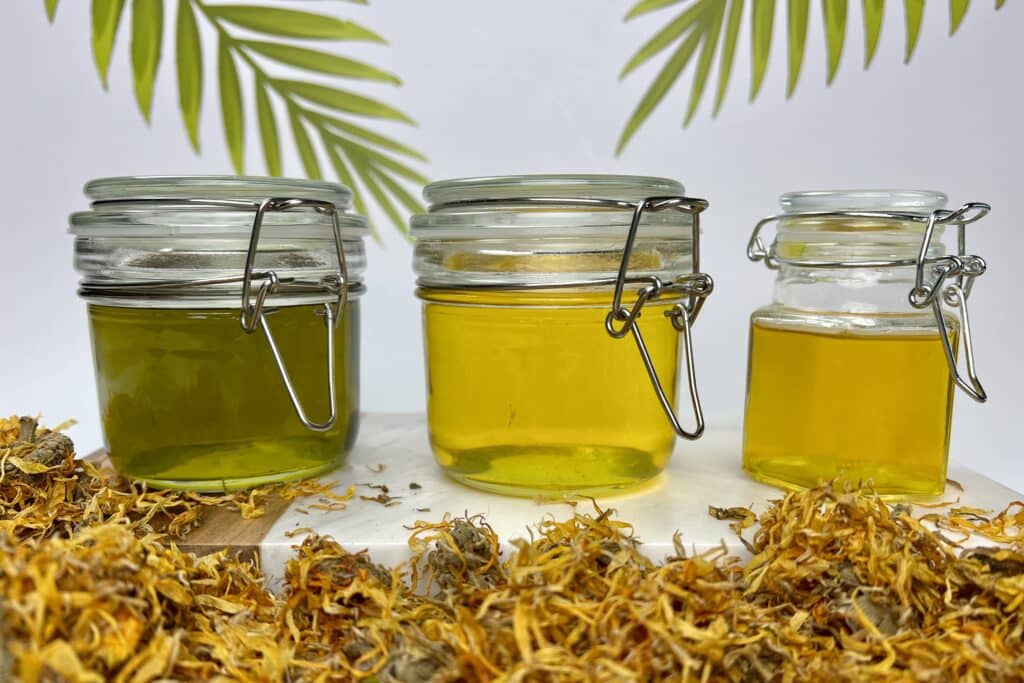
How to Make Herb and Flower Infused Oils
Table of Contents
Infusing herbs and flowers in oils is a DIY beauty secret that is simple but powerful. If you make your own homemade skin care already, then you know the benefits of using real, whole ingredients to make moisturizing and nutritious skin care that works.
Creating your own infused oil at home couldn’t be easier and it adds nutrient-rich plant ingredients usually found in high-end skincare products to your favorite carrier oils.
How do you use infused oils? Simply mix them in with your body butter, balm and salve recipes. You can also use them directly on the skin as a body, face, or massage oil.
3 Easy DIY Body and Face Oils
I’ve developed three recipes using some of my favorite dried flowers and herbs that I’ve used in skin care products over the years. I love using them because they’re gentle and effective. The three recipes are:
- Energizing Peppermint Body Oil
- Calming Calendula Body Oil
- Rejuvenating Lavender Face Oil
Here is a bit more information on the ingredients in these:
Herbs and Flowers
Peppermint: This widely beloved herb is used in culinary and cosmetic recipes. It’s the familiar taste from toothpaste, mouthwash, breath mints, gum, and more. It has astringent, cooling, anti-inflammatory, hydrating and circulation-promoting properties. In the body oil recipe that I’ve developed, you only need a little because of the strength of the dried peppermint. After using it you will smell delicious and your skin will feel toned and firm.
Calendula: This flower (pronounced “Ca-LEN-dyu-la”), also known as pot marigold, is a member of the daisy family. It’s extremely gentle and protective, so much so that it’s featured in many baby products. Calendula has a natural antihistamine (it is skin calming) and is packed with antioxidants. Additionally, it is moisturizing and has firming qualities on the skin. If I had to choose one flower that really does it all, Calendula would be it.
Lavender: The antiseptic, astringent, and anti-inflammatory properties of this flower make it a great choice for a facial toning oil. Lavender is great to use topically on the skin, as it is also known to help wounds heal quickly. And of course, it balances your skin’s moisture levels to calm and rejuvenate your skin.
Oils
Almond Oil: Pressed from the almonds we love to eat, almond oil is beneficial to all skin types. It does not clog pores, and the high levels of Vitamin E and omega-3 fatty acids helps diminish discoloration and allows moisture to penetrate deep into the skin. If you’re looking for a great all-around oil, this is it.
Apricot Oil: is my personal favorite. It is pressed from the pits of the apricot fruit, and is a delicate, light, and hydrating oil. Apricot Oil does not clog pores, and is especially great for mature and sensitive skin types. It makes skin radiant by increasing circulation and strengthening the skin barrier.
Rosehip Oil: Pressed from the little seeds left over after the petals are removed from roses, rosehip oil is a dry oil that’s developed a reputation as somewhat of a beauty superstar. Its high Vitamin A content promotes even skin tone and lightening of dark spots. It also encourages cell turnover to promote fresh-looking skin and helps smooth fine lines and wrinkles.
Jojoba Oil: This widely used beauty oil is a liquid wax, similar in structure to sebum, our skin’s own moisturizing oil. Because of this it helps balance our skin’s moisture levels, and the high levels of Vitamin E and minerals act as antioxidants to repair and soothe any stress or environmental damage that our skin may have taken on over the course of the day. It’s great on all skin types because of its balancing properties, and it is non-reactive.
Herb and Flower Infused Oil Recipes

Energizing Peppermint Body Oil
- ½ cup dried peppermint
- 8 oz Apricot oil
Calming Calendula Body Oil
- 1 cup dried calendula
- 8 oz Almond oil
Rejuvenating Lavender Face Oil
- ¼ cup dried flowers – mostly lavender, with a little calendula sprinkled in
- 1 oz rosehip oil
- 3 oz jojoba oil
Note on essential oils: I didn’t use any in these recipes because the botanicals smell amazing on their own. But if you want to enhance the scent of the final product, use up to 6 drops of EOs per 1 oz finished oil product.
The instructions to create each recipe above are as follows:
- Put your dried flowers in a glass jar with a lid
- Add the carrier oil to completely cover the flowers
- In a double-boiler setup, place your sealed jar in a pot of water
- Simmer over low heat for 3 hours
- Let oil cool
- Strain the flowers from the cooled oil and the oil is ready for use
- Note: you can compost the strained flowers, they are wonderful in the garden
The above is a fast technique to infuse your oil. Below are instructions on another more traditional way to do it that takes a bit longer.
Traditional infusion: Put your botanicals submerged in your selected carrier oil in a glass jar with a lid. Place this in a cool and dark place for 4 – 8 weeks. Once done you can strain the flowers and the oil is ready for use.
Recipe Video
Your skin is about to feel gorgeous and cared for with these recipes. You can also use them to make holiday gifts to pamper your friends and family. Since nothing beats a homemade gift with pure, lush ingredients, it is sure to be loved.
I hope you enjoyed these recipes. Please feel free to comment below with any questions or feedback you may have.
